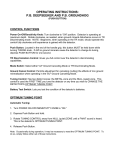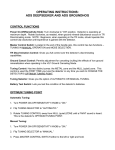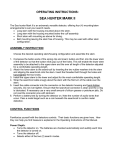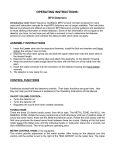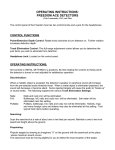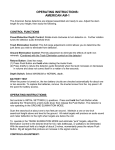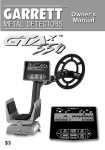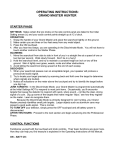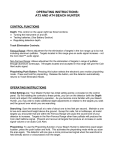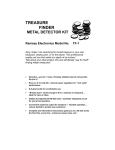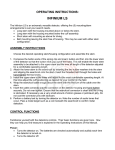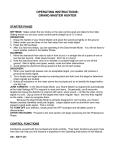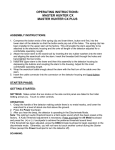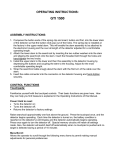Download OPERATING INSTRUCTIONS:
Transcript
OPERATING INSTRUCTIONS: MASTER HUNTERS ADS II AND ADS III CONTROL FUNCTIONS Power/Sensitivity Knob: Turn clockwise until switch clicks “on.” This engages the battery test and the battery condition is indicated by the meter. If NiCad batteries are used they will register in section marked NICAD on ADS III. Rotate further from the “MAX” position, as needed, when ground mineral when ground mineral disturbance occurs in the TR/Discriminate mode. NOTE: Beginners, when operating in the TR mode, should operate this control fully clockwise until experience is gained with the detector. Tone Control: Adjusts tone for preferred sound. Audio Control: Adjusts audio to threshold level. (Minimum sound you can hear.) Tuning Selector: Three-position switch gives option of Automatic, Semi-Automatic, or Manual operation. Ground Cancel Control: Provides adjustment for canceling (nulling) the effects of iron ground mineralization when operating in the VLF Ground Canceling mode. Discrimination Control: Gives you full control over the detector’s discriminating capabilities. Primary Discrimination Mode Selector: (Panel mounted.) Selects the primary discriminate mode. Master Control Switch: Selects one of the six modes/functions on the ADS III or one of the four modes/functions on the ADS II. Mode Identifier Panel: Identifies modes/functions available. Flashing LED light indicates battery check and mode/function selected on ADS III only. Depth Indicating Meter: (ADS III only.) Indicates depth of coin size targets. MODE IDENTIFIER PANELS The Mode Identifier Panel (ADS II and III) and the Primary Discrimination Mode Selector switch (panel mounted) are correspondingly color-coded to indicate Mode/Function relationship. The Mode/Function selected is indicated by flashing LED’s on ADS III only. With the panel mounted switch in the upward (red) position, the detector will be operating in the VLF/Discriminate (primary) mode when the Master Control switch is pressed to the right and released. When the Master Control switch is pressed to the right and held, the detector will be operating in the TR/Discriminate (secondary) mode. With the panel-mounted switch in the downward (yellow) position, the detector will be operating in the TR/Discriminate (primary) mode when the Master Control switch is pressed to the right and released. When the Master Control switch is pressed to the right and held, the detector will be operating in the VLF/Discriminate (secondary) mode. COIN DEPTH – PINPOINTING Note: These functions available only to the ADS III (calibrated to the 7.5” Co-Planar coil). To read depth in inches or millimeters, pinpoint the target, raise the searchcoil slightly above ground and press the Master Control switch to the left and hold. Place the searchcoil on the ground and slide searchcoil back over the target. The Meter pointer will indicated depth of a coin size target and will hold the reading until the switch is released. For correct depth reading, it is important that the detector be correctly adjusted in the VLF Ground Cancel mode. The maximum detector signal occurs when the target is below the are marked “X” on the searchcoil. When the Master Control switch is pressed to the left and held, the detector is switched into the electronic pinpointing and manual tuning mode (even if operating in the automatic mode). Slide the searchcoil back and forth across the target. The detector gives a more pronounced signal when the target is directly beneath the center of the searchcoil. Depth reading and electronic pinpointing can be accomplished simultaneously. Raise searchcoil; press the Master Control switch to the left and hold; lower searchcoil to the ground and slide back and forth across the target area. The depth will register correctly on the meter when the target is pinpointed. MASTER CONTROL SWITCH ADS III Six Function: 1. VLF Ground Cancel – Press left and release, non-discriminate. 2. Coin Depth – Press left and hold. 3. Electronic Pinpointing – Press left and hold. 4. VLF Discrimination – Press right and release. 5. TR Discrimination – Press right and hold. 6. Instant Retuning – Press right or left (depending upon which mode you are using) and release. The Master Control switch is a center position, spring return, two-direction switch. With the (panel mounted) Primary Discrimination Mode Selector in the upward (red) or VLF/TR position, these six modes/functions are available. Functions 4 and 5 are reversed when the panelmounted switch is in the downward (yellow) or TR/VLF position. ADS II Four Function: 1. VLF Ground Cancel – Press left and release, non-discriminate. 2. Instant Retuning – Press right or left (depending upon which mode you are using) and release. 3. VLF Discrimination – Press right and release. 4. TR Discrimination – Press right and hold. With the (panel mounted) Primary Discrimination Mode Selector in the upward (red) or VLF/TR position, these four modes/functions are available. Functions 3 and 4 are reversed when the panel-mounted switch is in the downward (yellow) or TR/VLF position. TUNING SELECTOR – AUDIO THRESHOLD TUNING SELECTOR: 1. MANUAL: Audio level is maintained by manually pressing the Master Control switch on the handle. 2. AUTOMATIC: Audio level is maintained by the detector. 3. SEMI-AUTOMATIC: Audio level is maintained as in Manual until the detector is positioned parallel with the ground. The detector then switches to Automatic. (Note: More uses and benefits of this position can be found in other sections of these instructions.) AUDIO THRESHOLD: Correct adjustment of audio threshold level is critical to achieve maximum results. Operating above or below minimum sound level decreases the effective sensitivity of your detector. 1. Turn Power knob to MAX position. Battery condition will register on meter. 2. Place tuning selector in automatic position for tuning. 3. Adjust audio level to threshold minimum sound level. 4. Adjust tone to desired pitch. (Readjustment of audio level may sometimes be necessary.) Note: Audio and tone controls should need no further adjustment unless controls are physically changed. Your detector can be switched off and on without need of readjustment. 5. Position tuning selector as desired to operate. GROUND/SALT WATER CANCELING Automatic Ground Canceling: Determine if adjustment is needed as in Manual position, then as each control adjustment is made, the detector will automatically retune to the predetermined audio level. Semi-Automatic Ground Canceling: Determine adjustment as in Manual position, then raise searchcoil until the detector is parallel with the ground. Make control adjustment and the detector will automatically retune to pre-determined audio level. Lower searchcoil toward the ground and the detector will return to the Manual mode. Check response. Raise searchcoil again and adjust Ground Cancel control as above, if needed. Salt Water Canceling: Place the panel-mounted Primary Discrimination Mode Selector in the (downward) TR/VLF, yellow position. Press the Master Control switch to the right and release, with the discrimination control at “0” position. To determine necessary adjustment, lower searchcoil to the surface of the wet sand, making sure no metallic targets are under the searchcoil. If the audio level increases, the discrimination control is increased approximately two numbers clockwise. Press the Master Control switch to the right and release. Lower the searchcoil to the beach. If the audio level now decreases, the discrimination control should be turned one number counterclockwise. Press the Master Control switch to the right and release. Continue this tuning process until there is no chance or very little change when the searchcoil is lowered to the wet salt beach. The adjustment is slightly critical in the last stages, usually requiring only slight rotation of the control. When the detector is properly adjusted, it eliminates the effects of salt water, gives maximum depth capability, and operates at a discrimination level that rejects foil, nails, and rusty bottlecaps. Rings and nickels, however, will not be rejected at this setting. TR DISCRIMINATION TR Discrimination Capabilities: Factory calibration zero discrimination is the factory calibrated position for metal/mineral ore sampling, etc. The fully counterclockwise “clicked” position is zero discrimination on the ADS II and III. Never rotate the DISCRIMINATION CONTROL farther clockwise than necessary to reject the targets you want rejected. The numbers on the DISCRIMINATION CONTROL are placed there for your ease in remembering your detector’s rejection settings. Bench test your detector until you know exactly where various unwanted targets are rejected. TR Operation (Manual): 1. Turn Power knob to MAX position. 2. Place tuning selector in Automatic position for tuning. Press Master Control switch to the right and release. 3. Adjust audio threshold and tone to desired pitch. Place tuning switch in Manual for operation. These are “set and forget” controls. 4. Place Primary mode selector in the downward (yellow) or TR/Discriminate position. 5. Place the searchcoil on the ground, press the Master Control switch to the right and release. This activates the TR/Discriminate mode as the Primary mode. In the TR/Discriminate mode, the detector will not cancel the ground minerals. 6. Move the searchcoil side-to-side while walking. Keep searchcoil in contact with the ground. If ground minerals cause sound fluctuations: (1) rotate Power/Sensitivity control clockwise until sound is less erratic and/or (2) adjust Audio control slightly until the audio level just becomes silent. BENCH TEST (NON-DISCRIMINATION): It is best to learn all about your detector’s discriminating capabilities before you take it out into the field. Perform the following bench tests: 1. Rotate the TR DISCRIMINATION CONTROL fully counterclockwise. Depress the Push Button for one second to retune the detector to your pre-set Optimum Tuning Point. 2. Bring various metallic targets up to one inch from the bottom of the searchcoil. The speaker sound and the meter will increase. This is TRUE TR, NON-DISCRIMINATING operation. BENCH TEST (DISCRIMINATION): 1. Rotate the control to approximately the number “3” position. The audio and meter will begin to decrease when small nails are scanned across and one inch from the bottom of the searchcoil. 2. Rotate the control to approximately the number “7” position. The audio and meter will begin to decrease when bottlecaps are tested. You will note that nails, foil, and other small junk items will also be rejected. 3. Rotate the control further clockwise and pulltabs will begin to be rejected. At this setting you will note that nickels and some rings will also be rejected. The conductivity of these two items is not great enough to cause the detector to respond as “GOOD”. IMPORTANT NOTES: AUTOMATIC TUNING operation causes an audio and meter OVERSHOOT of which you should be aware. When rejected targets produce a decrease in the audio and meter, an immediate INCREASE will be noted. This is not a false signal, but a normal AUTOMATIC TUNING characteristic that should be disregarded when heard. Co-planar searchcoils also produce a “back reading” characteristic, during discrimination, that you should be aware of. When rejected targets are brought closer than one inch to the bottom of the searchcoil a sharp audio “blip” is produced. This is caused by the coil winding configuration. These “blip” sounds are very different from the sound produced when coins are detected. When scanning and you hear a “blip”, raise the searchcoil two inches above the ground, retune, and scan back over the target. Junk items will not produce a sound at the twoinch height. Never rotate the TR DISCRIMINATION CONTROL farther clockwise than necessary to reject the targets you want rejected. The numbers on the TR DISCRIMINATION CONTROL are placed there for your ease in remembering your detector’s rejection settings. Bench test your detector until you know exactly where various unwanted targets are rejected. See FIELD APPLICATIONS, this manual, for additional operating tips and detector field applications. DETECTOR SERVICING Tips to keep your detector working correctly: a. The detector is a sensitive electronic instrument and, although it is built to be rugged, care in transporting and handling may extend its life. b. Do not subject detector to high temperatures, such as storing it in an automobile trunk. c. Keep detector clean. Wipe housing and wash coil after use if necessary. Protect from dust and sand as much as possible. Disassemble stem and clean after use in sandy areas. d. For storage periods longer than one month, remove batteries from battery tray. e. Never use spray cleaners or lubricants on the P.C. board or controls. Such materials leave harmful residues. In case of difficulty, follow these steps to insure your detector is not sent needlessly to the factory. If the detector must be returned, be sure to include a letter in the box with the detector, describing the problem, how often it occurs, and any special conditions under which the problem occurs. 1. The detector does not operate at all. a. Check battery condition using battery test meter while the detector is switched on. b. Check for proper assembly of detector, especially coil and battery tray installation. c. Operate all controls for erratic or intermittent operation. 2. The batteries seem to run down quickly. a. Remember, the group of batteries marked “1” powers the detection circuitry of and the group of batteries marked “2” powers the audio (sound) circuitry. b. Batteries should last from 25 to 50 hours. Battery life will vary depending on the make and freshness of battery, the type of detector and how it is used. c. The battery check meter is an indicator as to battery condition. Quite often the detector may be operated below the battery mark, without loss of sensitivity as long as (1) the detector is not erratic, does not drift, or otherwise operate incorrectly and (2) the sound is suitably loud. d. Earphones will extend the life of the #2 batteries significantly. e. Rechargeable batteries may be used with no loss in performance, although their characteristics cause the meter to read low even when fully charged. Expect only 12 to 25 hours of operation per charge. 3. Oscillating or pulsing sound from speaker. a. This effect is almost always due to external sources. Some possible sources are other metal detectors nearby, arc welders, fluorescent lights, television sets, power lines, and CB radios. In most cases you must turn off the noise source or move to another area. b. If the problem persists when the detector is moved from one location to another, the instrument may need servicing. 4. Erratic sound from speaker; sound goes on and off. a. Loose battery connection or a defective battery. Be sure each battery “snaps” into the battery tray slot. Try substituting one battery at a time until a defective battery is found. b. Loose coil connector. Be sure that the connector is inserted completely and the locking ring is tightened. c. The wing nut assembly is not properly tightened, allowing the coil to move. Hand tighten as tightly as possible…use no tools. d. The cable assembly is not wrapped around the stem tightly to eliminate movement of the wire. e. The small screw in the coil connector, if loose, may cause erratic operation. f. A defective coil or detector. Try another coil if available to isolate the problem. (If problem persists, return both detector and coil for repair so a thorough check can be made. 5. The detector drifts out of tune. (Note: a number of problems may be incorrectly interpreted as drift.) a. Tuning changes that occur when the coil is raised from or lowered to the ground are not caused by drift. This is the normal response of the detector to the ground minerals when in TR mode or when incorrectly adjusted in VLF mode. See instructions. b. The tuning changes immediately after the detector is taken from the inside to the outside. A thermal stabilization time is required for any sensitive electronic instrument. c. There are some instances where a failure in the detector causes a steady drift. If such a failure is suspected, determine the severity of the change and describe the amount of meter movement in a letter to the repair technician. 6. A fuzzy sound from speaker may be caused by metal shavings or sand in speaker. Operate the detector at full volume, then turn it over, speaker down, and shake. 7. Loose metal particles which rattle inside the detector housing. Pop rivets are used in the manufacture of the detectors and occasionally a portion of the rivet will shake loose during shipping. This is normal and will not cause a failure of the detector or the rivet. 8. Before returning the detector to the factory for repair, be sure: a. You have read the instructions thoroughly. b. You have checked the detector as described above. c. You have checked with your local dealer, especially if you are still somewhat unfamiliar with the equipment. d. You have described the symptoms and the conditions under which they occur in a short note to the repair technician. e. You have carefully packed the detector in the original shipping carton or other suitable box. DO NOT ship stems, arm rests, or headphones unless they are a part of the problem. Return all coils unless the problem is a mechanical nature. Be sure all parts are secured in the box to prevent damage. 9. All equipment is returned UPS or parcel post unless written authorization is given by you to ship collect by air parcel post, UPS Blue (air) or air freight. FIELD APPLICATIONS VLF/TR DUAL DISCRIMINATION: Garrett gives you two methods to use to determine if the detected object is worth digging. Target identification can be made quickly, easily, and without loss in depth of detection. METHOD ONE (Searchcoil detection width method): Garrett’s special multiwound searchcoils make the VLF mode ferrous iron identification quick and easy. METHOD TWO (TR discrimination method): If Method One indicates the object is not iron, you can quickly determine if it is a coin and not foil, etc., by flipping to the TR mode. These methods, described below can be easily mastered in one day’s searching. A few seconds’ test is all that is needed to determine if detected object is worth digging: Method One: (Ground Cancel Mode). IDENTIFY IRON OBJECTS. Do not confuse this method with the “double blip.” All brands of VLF’s produce double blips over horizontal nails. When you detect a target, cross over it twice, making an “X”. If the object is a nail lying in a horizontal position, the detector will produce a quick “blip, blip” sound. Magnetic (ferrous) iron objects produce a much wider response than coins. Non-ferrous objects, such as coins, tinfoil, brass, copper, etc., produce a much more narrow response. This identification method is quick and easy. Bench test by passing a bottlecap and a coin (in a flat position in relation to searchcoil) at approximately 3-4 inches distance. After just one day’s practice on the bench and in the field, you will no longer be bothered with magnetic iron junk. Method Two: Lower the searchcoil to the ground at the point of the strongest audio signal (when the searchcoil “X” is directly above the target). Depress the Push Button for one second to retune. Slide searchcoil forward and back, then side-to-side to pinpoint target. Slide searchcoil to one side so that the edge of searchcoil completely clears the target. Adjust VARIABLE DISCRIMINATION CONTROL to reject bottlecaps. Keeping the searchcoil on the ground, flip to the TR MODE. Slide searchcoil slowly back over the target. If target is foil, etc., the audio signal and meter pointer will decrease. If coin, etc., audio volume will increase and pointer will move to the right toward the GOOD position. NOTE: If you hear a “blip” as described in the Important Notes segment of TR Discrimination, you will know the object is a bottlecap, etc. The above-described procedures permit the quickest, easiest scanning/discriminating method available. You scan quickly, effortlessly, in the VLF ground canceling mode. Then, using Garrett’s Dual Discrimination Method, you quickly identify the target and…you lose little, if any depth. BUILDING SEARCHING: To search buildings for concealed caches and relics, flip to TR mode, adjust VARIABLE DISCRIMINATION CONTROL to reject nails. This setting gives good sensitivity to large objects but rejects nails. NOTE: Depending upon the operator’s experience, it may be necessary to reduce the sensitivity to achieve operational stability. PINPOINTING: It is easy to pinpoint buried targets. The maximum detector signal occurs when the target is directly below the “X” marked on the searchcoil. Pinpointing objects near the surface may require one or more techniques. As you scan, raise the searchcoil higher and higher above the ground until the object gives a distinct, faint audio signal. The object will then be directly below the searchcoil’s “X”. Another method is to “detune” the detector. When you hear the loudest signal, set the searchcoil directly on the ground at that point. Depress the Push Button until the detector retunes itself. Then scan back over the spot, keeping the searchcoil in contact with the ground. Since the detector is tuned directly to the target, you will hear a distinct, but faint, signal when the searchcoil “X” is directly above the target. If you use this method when operating in the VLF Ground Canceling Mode, it is not necessary to place the searchcoil in contact with the ground. You should perform the above pinpointing method with the searchcoil held approximately two inches above the ground. BEACHCOMBING: In searching the beaches, the wetted sand is usually so conductive that the VLF Ground Canceling Circuitry cannot tune them out completely. Also, some beaches contain black magnetic sand in scattered pockets. These pockets are usually of varying densities which also prevents perfect ground canceling. One method which greatly reduces most annoying beach situations is to hold the Push Button down, achieving AUTOMATIC MODE tuning. As you scan, the disturbances are somewhat “tuned out,” thus lessening their disturbing effects. SUCCESSFUL COIN HUNTING TECHNIQUES: Ground minerals vary from place to place. Some iron mineral concentrations are stronger than others. Consequently, you will find it necessary to change your operating methods from time to time. You may find areas that are devoid of minerals or areas that contain only slight amounts of minerals. Searching over these areas in the TR mode presents practically no problems. Some areas, however, contain heavy minerals. To reduce the effect of these minerals, decrease your detector’s sensitivity by rotating the SENSITIVITY control approximately one-half turn. Scan with the detector in either the SCRUB position or approximately two inches above the ground. You may operate with the detector speaker “silent” if it helps. You may also try another method; this is to operate in the VLF Ground Cancel Mode. When you receive a target signal and have the target pinpointed, move the searchcoil slightly off to one side of the target. Flip to the TR MODE and depress the Push Button until the detector retunes. Carefully scan back over the target MAINTAINING SLIGHT SOUND by keeping the searchcoil at constant height while listening to the speaker. If the speaker sound “dips” while over the target and then comes back on as you clear the target, you will know the target has been rejected by the TR Discriminate Mode and should not be dug. With just a few hours’ practice using these various techniques, you will find your efficiency has greatly improved and the number of coins you find will grow larger each time you go coin hunting. Metal detecting is just like any other activity or sport…the more you concentrate on what you are doing and the more you employ “perfect practice,” the better you will become. Make the effort it takes: it will pay off! CACHE (MONEY) HUNTING: In hunting for buried money and other valuables it is recommended that you use either the 10” or the 14” searchcoil to achieve maximum depth and wide-scan ground coverage. The VLF Ground Cancel Mode would usually be employed. Several factors influence detection of buried treasure…ground minerals, moisture, object size, length of time object has been buried, the kind of metal it is, and the size searchcoil used. While most post hole banks (small jars and pots of money) are usually no more than two feet deep, the Wells Fargo box or the Spanish gold bars may be at much greater depths. It should be noted that when detecting large metal objects, especially those made of iron, your detector will reach out beyond the edges of the searchcoil, sometimes as much as two or three feet. For example, an iron box 18 inches square may give a reading four to five feet wide. Much of your success in cache and treasure hunting will depend on your learning to tell the difference between small and large object signals. The ADS detector’s superior sensitivity on even small objects such as coins is a capability that is important in order for you to avoid digging unnecessary small metal objects. Many treasure hunters prefer to cache hunt and generally do not spend much time coin hunting except in very “hot” (old and rare) coin areas. They say that even if it takes them several months to find a good cache, the time has been well spent. DO YOUR RESEARCH! BATTLEFIELD AND RELIC HUNTING: The deep seeking, ground canceling, one-hand-operation features of the Push Button detector make it an ideal instrument for use on the battlefields and other relic areas. Searching in the VLF Ground Cancel Mode ensures maximum wide-scan coil coverage and deepest possible detection. The Mode Switch allows you the option of quickly checking targets in the TR Discriminate Mode to determine if they are ferrous or non-ferrous before digging. These detectors are particularly sensitive to brass items, making them ideal for locating belt buckles, buttons, and other brass military accoutrements. It is important to note that as you gain additional experience with your VLF/TR detector you will find yourself able to utilize the instrument more effectively in locating increasing amounts of relics at greater depths. PROSPECTING: Your VLF/TR detector has been specifically designed and tested to give reliable performance in all phases of treasure hunting, including prospecting, nugget and vein locating, mine searching and ore sample identification. Be sure to research some of the countless books covering all aspects of this subject, and practice the techniques described therein for maximum success. INDUSTRIAL APPLICATIONS: Your VLF/TR metal detector is well suited to locating underground pipes and cables. For detection of deeply buried pipes and cables, the larger searchcoils (10.5” and 14”) should be used. Other uses include locating nails and bullets in trees, thus preventing saw blade damage. Various police agencies use detectors for evidence recovery at the scene of crimes, such as finding bullets, fired cartridge cases, guns, and stolen money. COMPETITION TREASURE HUNTING: Many metal detector operators enjoy the thrill of participating in organized treasure hunts sponsored by the various treasure hunting clubs. Generally, hundreds of metal targets (usually coins) are buried at the hunt site. By paying an entry fee you may compete with treasure hunters from all over the country. At these competition hunts speed is of the essence! Not only must you scan very rapidly, you must also recover the coins or other targets quickly. The VLF/TR detector equipped with the 10.5” searchcoil is recommended, especially if grass at the competition area is high. At most hunts the VLF Ground Cancel Mode is used. If the hunt area contains metal trash you may reject it in an instant by using the Mode Switch to change modes and check the reading in TR Discriminate before digging. NOTICE: Since Garrett Electronics introduced its VLF/TR Deepseeking instruments, users have reported finding, at great depths, live ammunition in battlefield areas, as well as high voltage power line which are buried deeply for protection. Please use extreme caution in all of your recovery work when you locate any object that may not be treasure.











